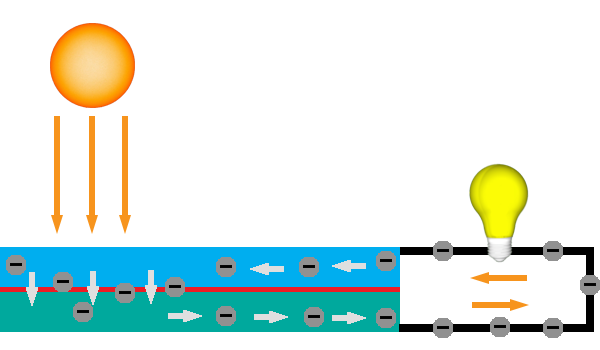PV module
Solar PV modules use the photovoltaic (PV) effect, which enables them to generate electrical current in upon exposure to light. PV modules are composed of individual cells wired together, current is generated when light hits one side of the cell and excites electrons that then pass through a one-way barrier forcing them to flow through a circuit to return to their point of origin. These electrons carry energy which can be used to power loads. There are many different technologies available and ways to design a system that can meet needs that range from simple lighting, to running appliances, pumping water or powering cities. A typical solar cell produces around .5V when exposed to sufficient light.
Contents
Construction
The vast majority of solar modules are composed of a few simple materials including the following by weight: 76% glass (panel surface), 10% polymer (encapsulant and backsheet foil), 8% aluminium (mostly the frame), 5% silicon (solar cells), 1% copper (interconnectors) and less than 0.1% silver (contact lines) and other metals (mostly tin and lead) [1]
Types
PV modules are composed of a few basic material groups.
Characteristics
Common module configurations
- A 36-cell module comprised of .5V cells would have a rated voltage of around 18V.
- A 60-cell module comprised of .5V cells would have a rated voltage of around 30 volts.
- A 72-cell module comprised of .5V cells would have a rated voltage of around 36V.
Projected life
A well-made solar module will continue functioning for decades, although all modules degrade with the passage of time. High-quality modules degrade at an average rate of .5% to 1% per year, whereas poorly made modules degrade even quicker. This is the primary difference between the different costs and qualities of modules.
Maintenance
There are no moving parts in solar PV modules and they are built out of durable materials. The only maintenance that is likely to ever be required a module is an occasionally cleaning if the module is in an area that lacks regular rainfall.
Recyclability
Notes
- ↑ IRENA End-of-Life Management Solar Photovoltaic Panels. https://www.irena.org/-/media/Files/IRENA/Agency/Publication/2016/IRENA_IEAPVPS_End-of-Life_Solar_PV_Panels_2016.pdf
